Temperature Distribution Characteristics and Action Pattern of Concrete Box Girder under Low-Temperature and Cold Wave Conditions
Abstract
:1. Introduction
2. Experimental Study
2.1. Model Design and Production
2.2. Measuring Point Arrangement
2.3. Meteorology Variation Due to Cold Wave Event
3. Temperature Testing Results of Concrete Box Girder
3.1. Temperature Time-Varying Rules
3.2. Temperature Distribution Rules
4. Numerical Simulation of Temperature Field
4.1. Finite Element Model
4.2. Model Validation
5. Vertical Temperature Gradient Pattern of Concrete Box Girders under Cold Wave Action
5.1. Vertical Temperature Gradient Curve
5.2. Temperature Gradient Extreme Value Analysis
5.2.1. Temperature Gradient Sample Data
5.2.2. Representative Value of Temperature Gradient Effect
5.3. Vertical Temperature Gradient Pattern under Cold Wave Action
6. Comparative Analysis with National Standards
6.1. Temperature Distribution Comparison
6.2. Temperature Self-Equilibrating Stress Comparison
6.3. Temperature Curvature Comparison
7. Conclusions
- (1)
- Based on the results of rigorous statistical analysis, the estimated return period was found to be a mere 49.76 days. Furthermore, for a 50-year return period, the projected amplitude of temperature reduction during cold waves is expected to reach 26.42 °C, surpassing the worst-case measured temperature reduction by a factor of 1.44.
- (2)
- The vertical distribution curve of the most unfavorable negative temperature difference in concrete box girders within this experimental area can be described by a combined exponential function. Based on the measured data, a calculation formula for the temperature vertical gradient that is suitable for practical engineering applications was proposed. This formula effectively encompasses the specifications outlined in JTGD60-2015, AASHTO, and BS5400, thereby providing invaluable guidance for designing concrete bridges in cold regions.
- (3)
- The vertical distribution of residual temperature Tr and vertical linear temperature differential Tv in the cooling mode decomposition of this article is basically consistent with the specifications of JTGD60-2015, AASHTO, and BS5400. These results demonstrate that the temperature gradient model system proposed in this study is economically reasonable, mitigating the risk of bridge cracking during operation.
Author Contributions
Funding
Institutional Review Board Statement
Informed Consent Statement
Data Availability Statement
Conflicts of Interest
References
- Stewart, C.F. Long Structures without Expansion Joints; Caltrans: California Department of Transportation: Sacramento, CA, USA, 1967.
- Massicotte, B.; Picard, A.; Gaumond, Y.; Oullet, C. Strengthening of a long span prestressed segmental box girder bridge. PCI J. 1994, 39, 52–65. [Google Scholar] [CrossRef]
- Liu, Y.; Liu, J. Review on temperature action and effect of steel-concrete composite girder bridge. J. Traffic Transp. Eng. 2020, 20, 42–59. (In Chinese) [Google Scholar]
- Fan, L.; Guo, Y.; Zhao, Y.; Wang, T. Climate characterization of the severe cold weather in Altay region during 1962–2017. Desert Oasis Meteorol. 2020, 14, 92–98. (In Chinese) [Google Scholar]
- Bai, S.; Boernan, H.; Xie, X. The variation characteristics of cold wave in Altay prefecture under climate warming background. J. Glaciol. Geocryol. 2015, 37, 387–394. (In Chinese) [Google Scholar]
- Zhang, Q.; Li, J.; Singh, V.P.; Xiao, M. Spatio-temporal relations between temperature and precipitation regimes: Implications for temperature-induced changes in the hydrological cycle. Glob. Planet. Change 2013, 111, 57–76. [Google Scholar] [CrossRef]
- DelSole, T.; Shukla, J. Specification of wintertime North American surface temperature. J. Clim. 2006, 19, 2691–2716. [Google Scholar] [CrossRef]
- Quesada, B.; Vautard, R.; You, P. Cold waves still matter: Characteristics and associated climatic signals in Europe. Clim. Chang. 2023, 176, 70. [Google Scholar] [CrossRef]
- Messori, G.; Faranda, D. On the systematic occurrence of compound cold spells in North America and wet or windy extremes in Europe. Geophys. Res. Lett. 2023, 50, e2022GL101008. [Google Scholar] [CrossRef]
- Song, Z.; Xiao, J.; Shen, L. On temperature gradients in high-performance concrete box girder under solar radiation. Adv. Struct. Eng. 2012, 15, 399–415. [Google Scholar] [CrossRef]
- Zhang, H.; Wang, P.; He, S.; Li, Y.; Chen, F.F.; Sun, N.N. Research of thermal effect of cable-stayed bridge with a separated side-box steel-concrete composite girder under solar radiation. Adv. Civ. Eng. 2021, 2021, 8812687. [Google Scholar] [CrossRef]
- Abid Sallal, R.; Tayşi, N.; Özakça, M. Temperature records in concrete box-girder segment subjected to solar radiation and air temperature changes. IOP Conf. Ser. Mater. Sci. Eng. 2020, 870, 012074. [Google Scholar] [CrossRef]
- Lee, J.; Kalkan, I. Analysis of thermal environmental effects on precast, prestressed concrete bridge girders: Temperature differentials and thermal deformations. Adv. Struct. Eng. 2012, 15, 447–459. [Google Scholar] [CrossRef]
- Roberts-Wollman, C.L.; Breen, J.E.; Cawrse, J. Measurements of thermal gradients and their effects on segmental concrete bridge. J. Bridge Eng. 2002, 7, 166–174. [Google Scholar] [CrossRef]
- Lu, Y.; Li, D.; Wang, K.; Jia, S. Study on solar radiation and the extreme thermal effect on concrete box girder bridges. Appl. Sci. 2021, 11, 6332. [Google Scholar] [CrossRef]
- Shen, Q.; Chen, J.; Yue, C.; Cao, H.; Chen, C.; Qian, W. Investigation on the through-thickness temperature gradient and thermal stress of concrete box girders. Buildings 2023, 13, 2882. [Google Scholar] [CrossRef]
- Abid, S.R.; Tayşi, N.; Özakça, M. Experimental analysis of temperature gradients in concrete box-girders. Constr. Build. Mater. 2016, 106, 523–532. [Google Scholar] [CrossRef]
- Li, H.; Zhang, Z.; Deng, N. Temperature field and gradient effect of a steel-concrete composite box girder bridge. Adv. Mater. Sci. Eng. 2021, 2021, 9901801. [Google Scholar] [CrossRef]
- Gu, B.; Chen, Z.; Chen, X. Temperature gradients in concrete box girder bridge under effect of cold wave. J. Cent. South Univ. 2014, 21, 1227–1241. [Google Scholar] [CrossRef]
- Larsson, O.; Thelandersson, S. Estimating extreme values of thermal gradients in concrete structures. Mater. Struct. 2011, 44, 1491–1500. [Google Scholar] [CrossRef]
- Nassar, M.; Amleh, L. The effect of projected air temperatures on concrete box girders thermal gradients and effective temperatures in Canada. Results Eng. 2023, 20, 101453. [Google Scholar] [CrossRef]
- Shi, T.; Sheng, X.; Zheng, W.; Lou, P. Vertical temperature gradients of concrete box girder caused by solar radiation in Sichuan-Tibet railway. J. Zhejiang Univ. Sci. A 2022, 23, 375–387. [Google Scholar] [CrossRef]
- Zhang, N.; Zhou, X.; Liu, Y.; Liu, J. In-situ test on hydration heat temperature of box girder based on array measurement. China Civ. Eng. J. 2019, 52, 76–86. (In Chinese) [Google Scholar]
- GB 50010–2010; Code for Design of Concrete Structures. China Architecture Publishing & Media Co., Ltd: Beijing, China, 2015.
- Liu, J.; Liu, Y.; Zhang, G. Experimental analysis of temperature gradient patterns of concrete-filled steel tubular members. J. Bridge Eng. 2019, 24, 04019109. [Google Scholar] [CrossRef]
- Wang, Y.; Ma, G.; Ren, F.; Li, T. A constrained Delaunay discretization method for adaptively meshing highly discontinuous geological media. Comput. Geosci. 2017, 109, 134–148. [Google Scholar] [CrossRef]
- Lee, D.; Schachter, B. Two algorithms for constructing a Delaunay triangulation. Int. J. Parallel Program. 1980, 9, 219–242. [Google Scholar] [CrossRef]
- El-Zafrany, A.; Cookson, R. Derivation of Lagrangian and Hermitian shape functions for triangular elements. Int. J. Numer. Methods Eng. 1986, 23, 275–285. [Google Scholar] [CrossRef]
- Liu, J.; Liu, Y.; Fang, J.; Liu, G.-L. Vertical temperature gradient patterns of I-shaped steel-concrete composite girder in arctic-alpine plateau region. J. Traffic Transp. Eng. 2017, 17, 32–44. (In Chinese) [Google Scholar]
- Liu, J.; Liu, Y.; Ma, Z.; Zhang, G.-J.; Lyu, Y. Temperature gradient action of steel-concrete composite girder bridge: Action pattern and extreme value analysis. China J. Highw. Transp. 2022, 35, 269–286. (In Chinese) [Google Scholar]
- JTG D60–2015; General Specifications for Design of Highway Bridges and Culverts. Ministry of Transport: Beijing, China, 2015.
- American Association of State Highway and Transportation Officials. AASHTO LRFD Bridge Design Specification; AASHTO: Washington, DC, USA, 2020. [Google Scholar]
- BS5400; Steel, Concrete and Composite Bridges, Part 2. Specification for Loads. Steel and Concrete Bridges Standards Committee: Washington, DC, USA, 1978.
- Chen, Q. Effects of Thermal Loads on Texas Steel Bridges. Ph.D. Thesis, The University of Texas, Austin, TX, USA, 2008. [Google Scholar]

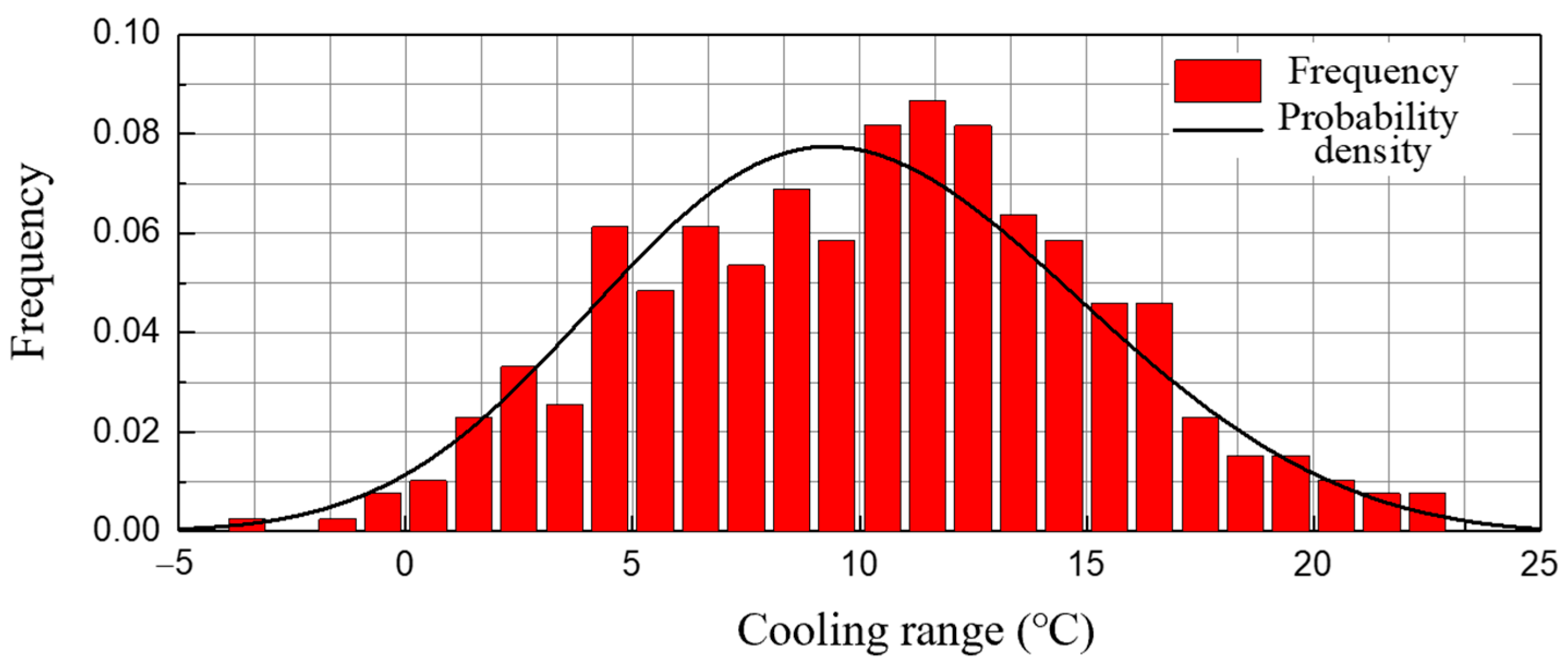




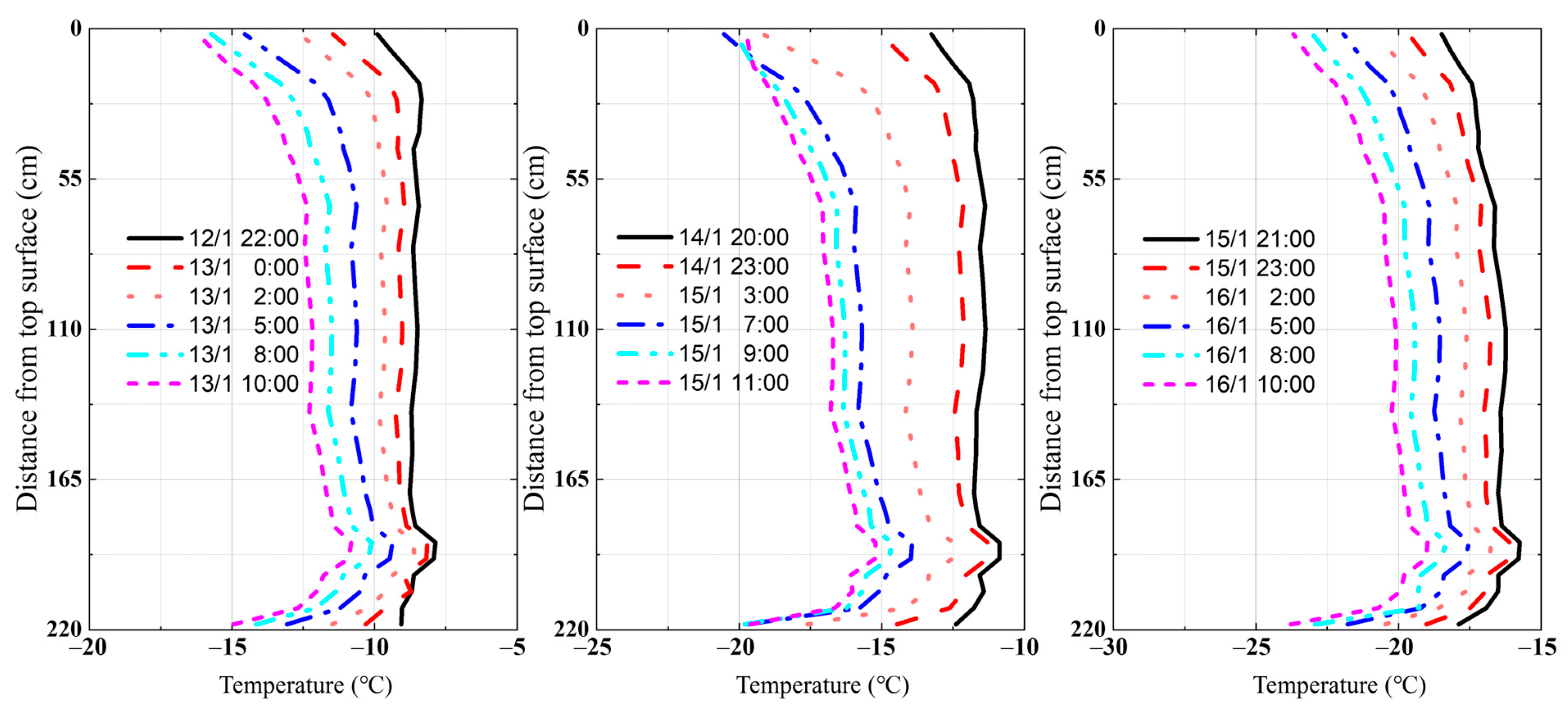
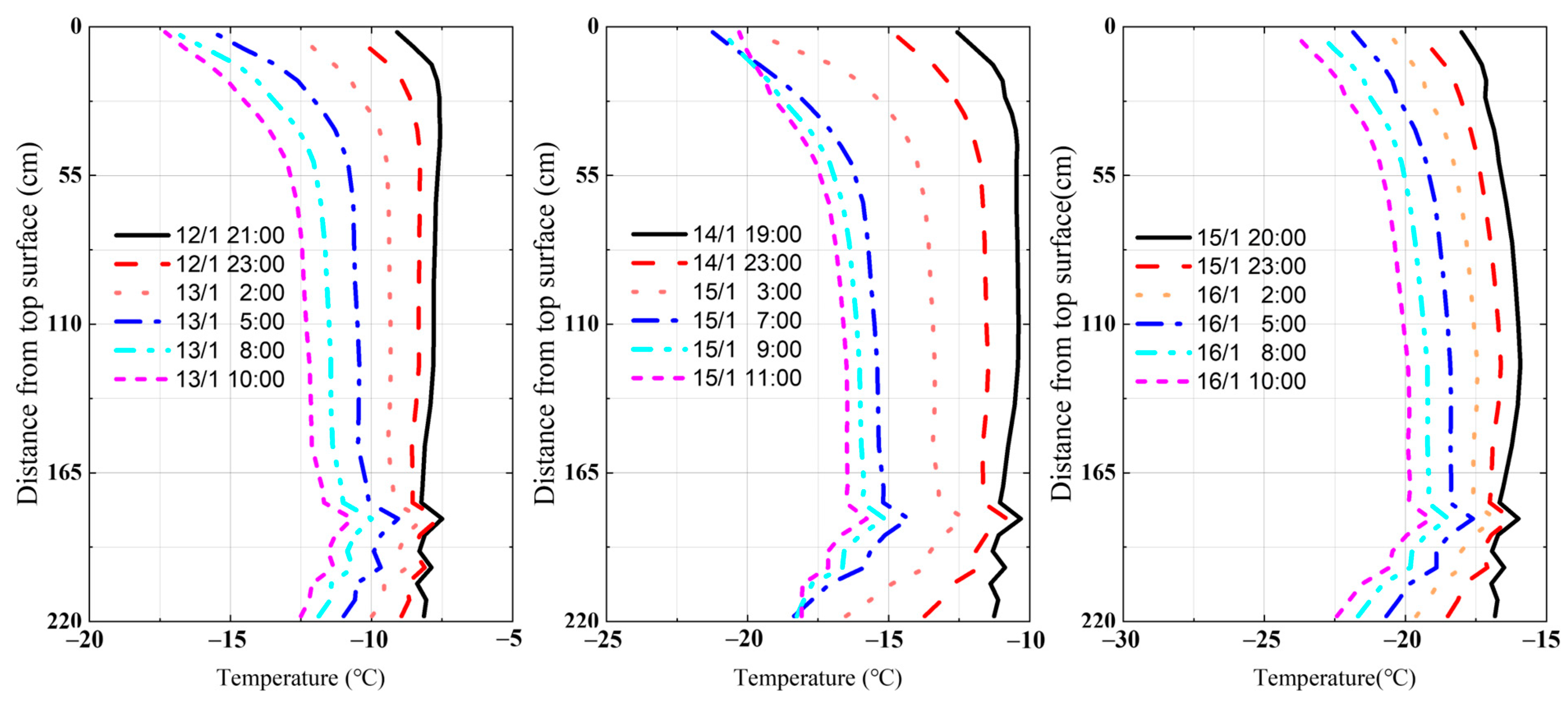

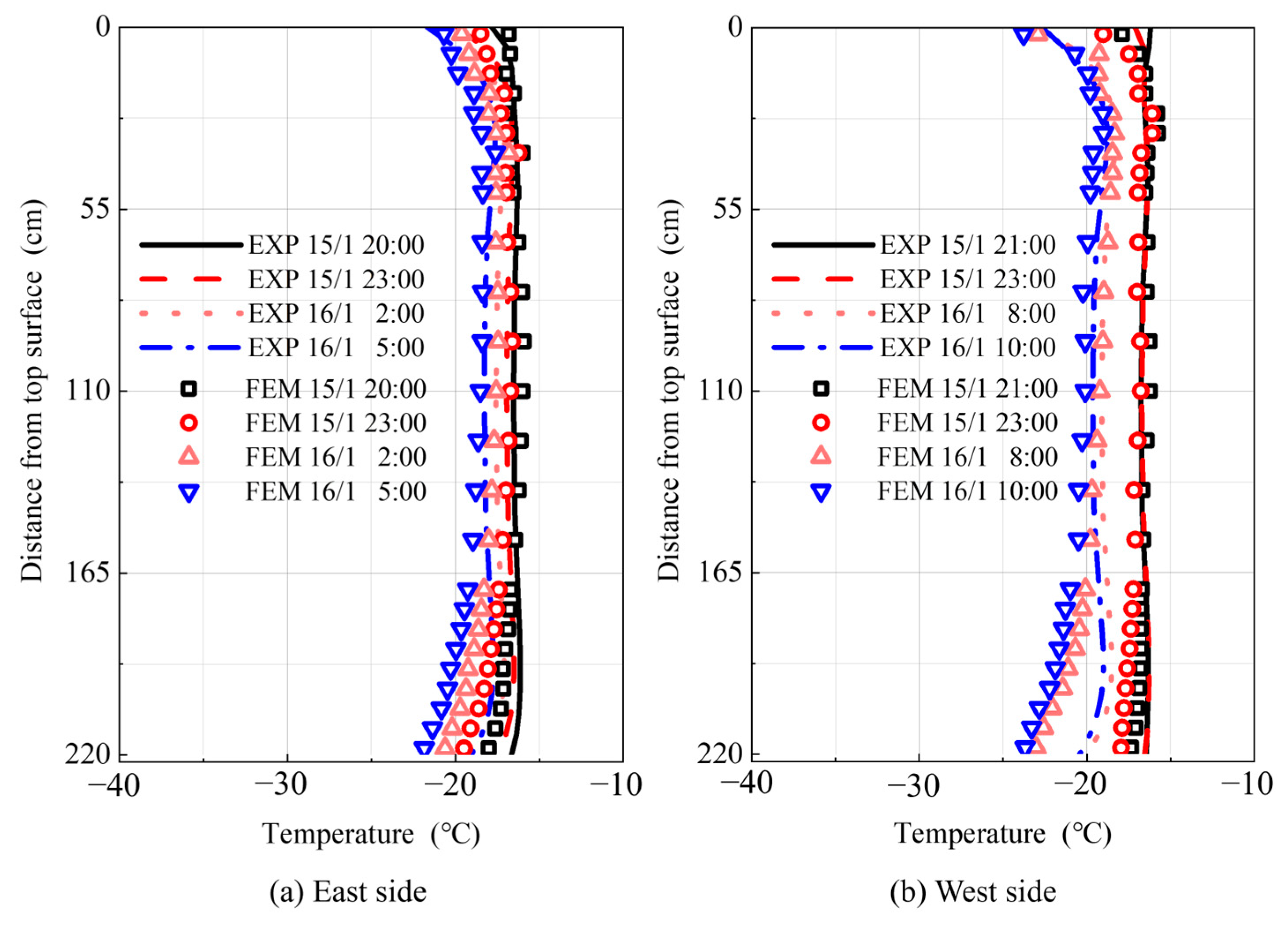
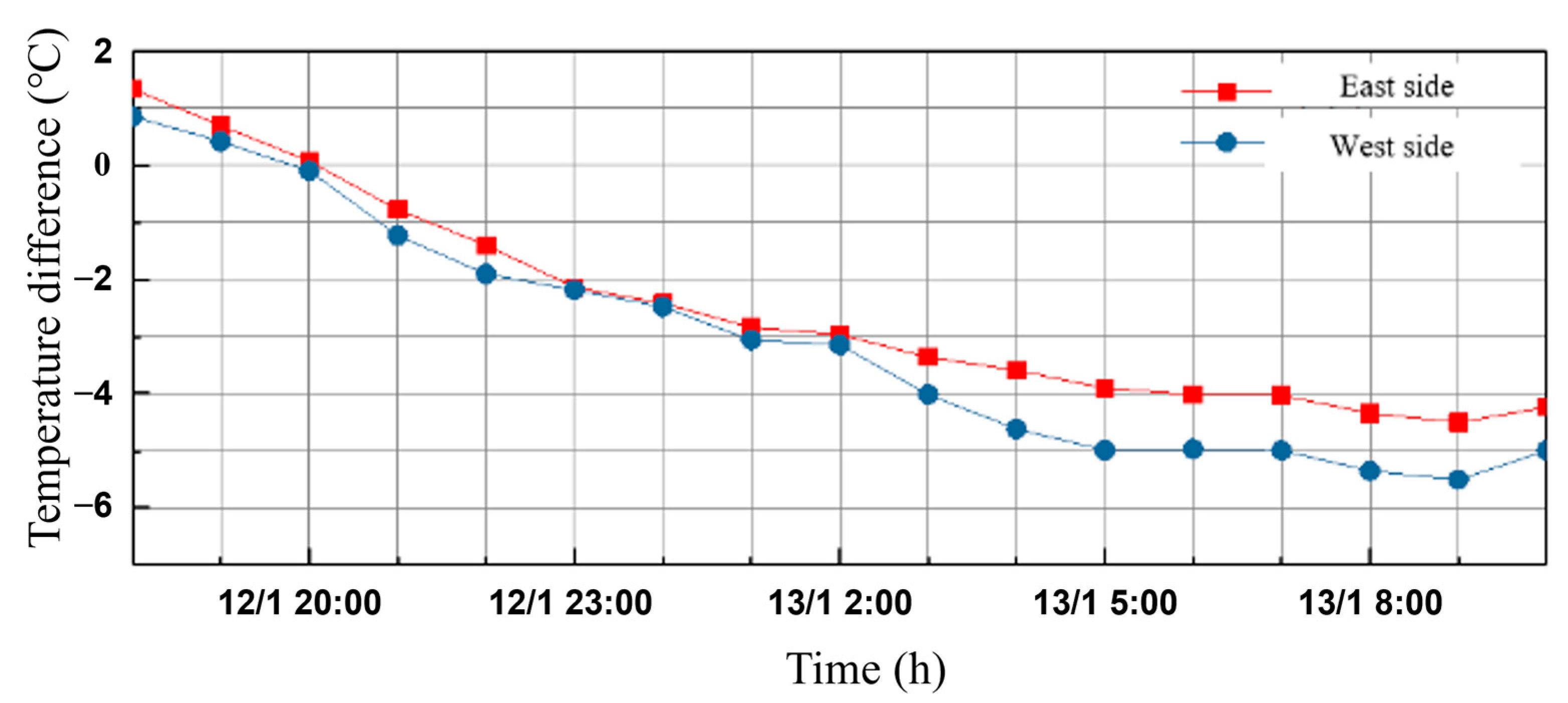
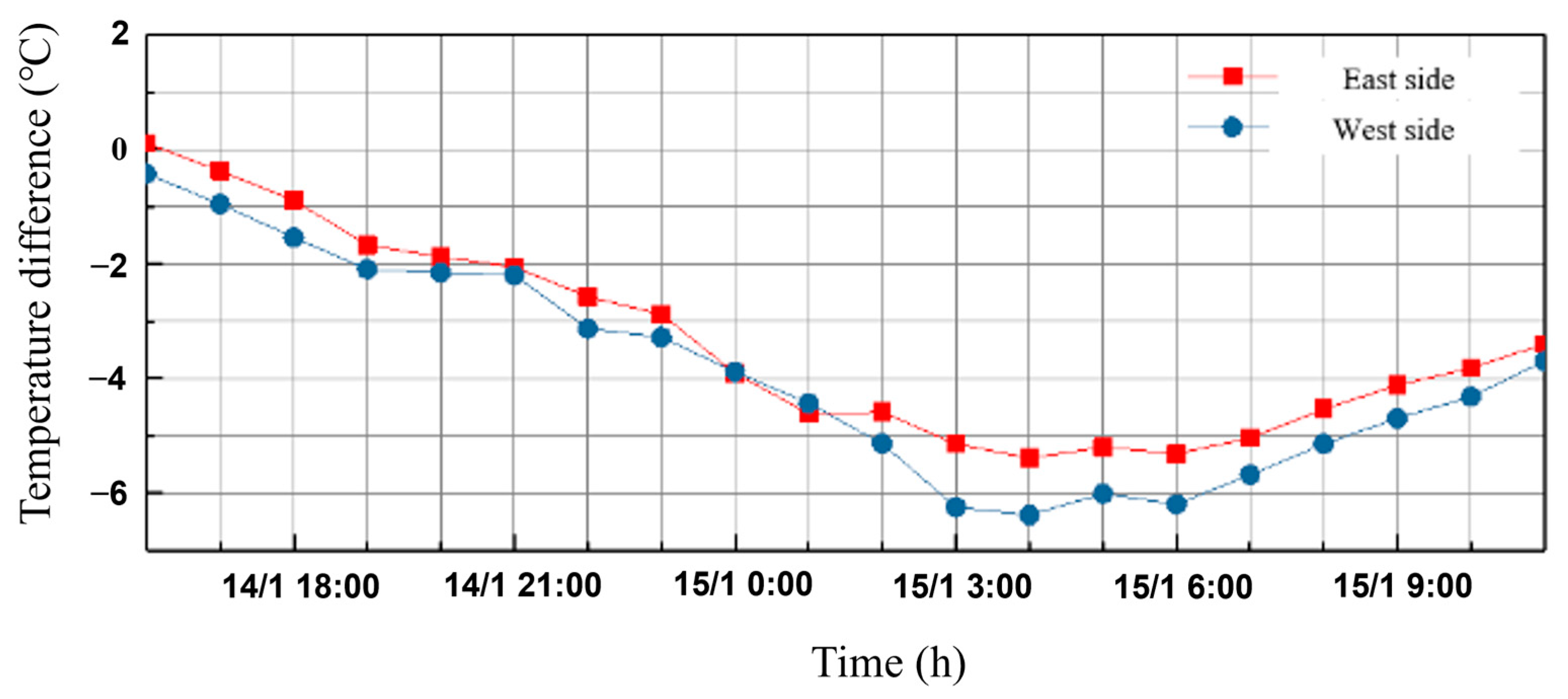

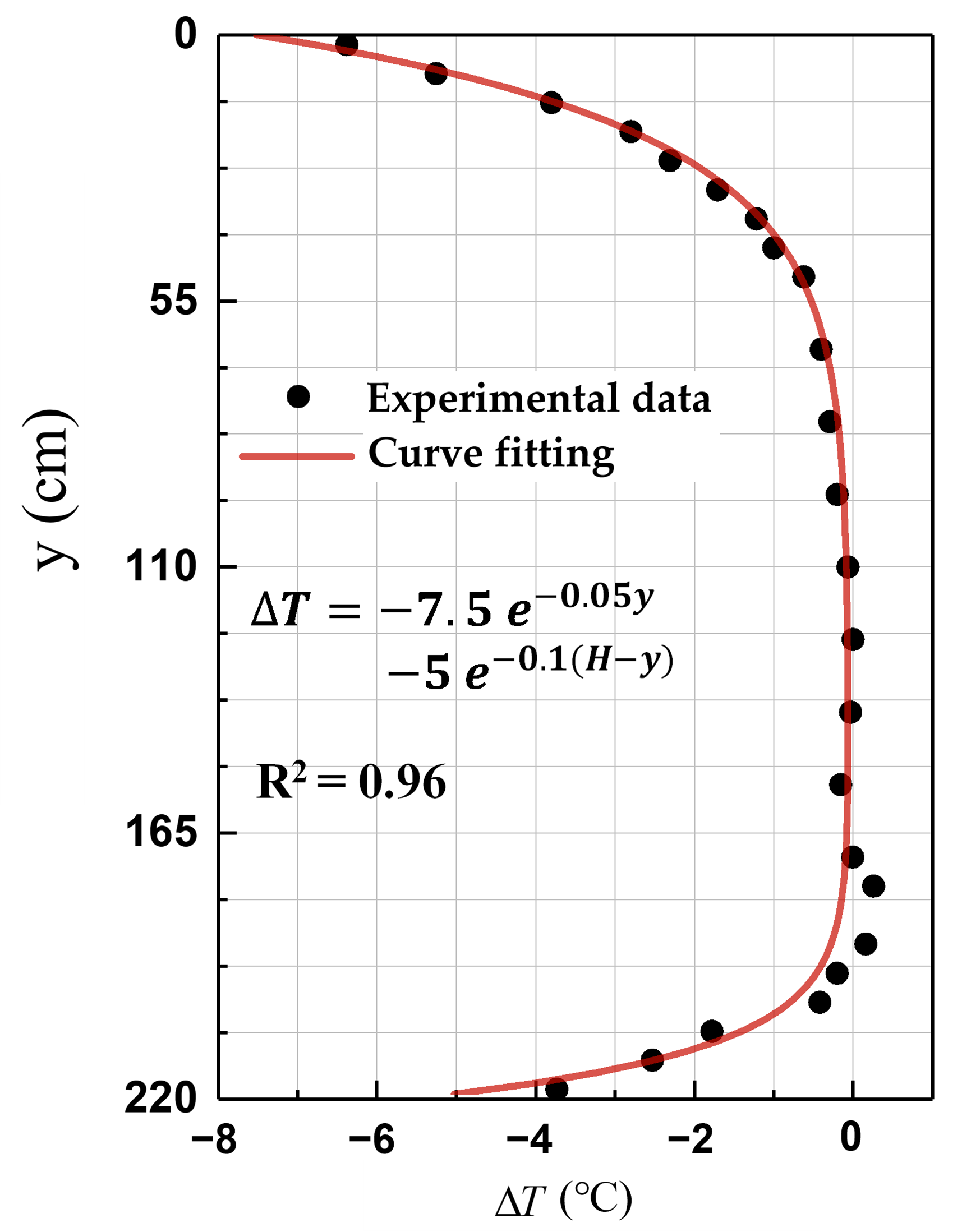

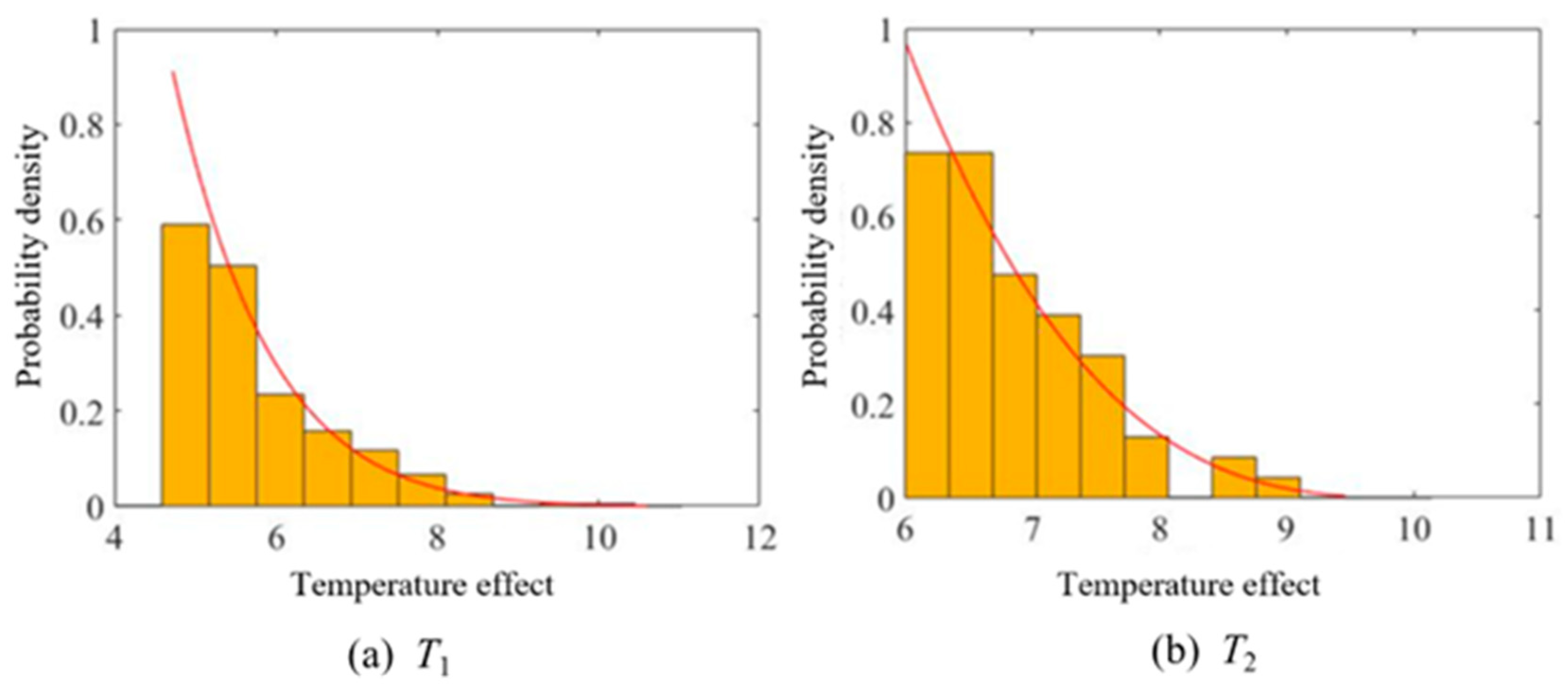

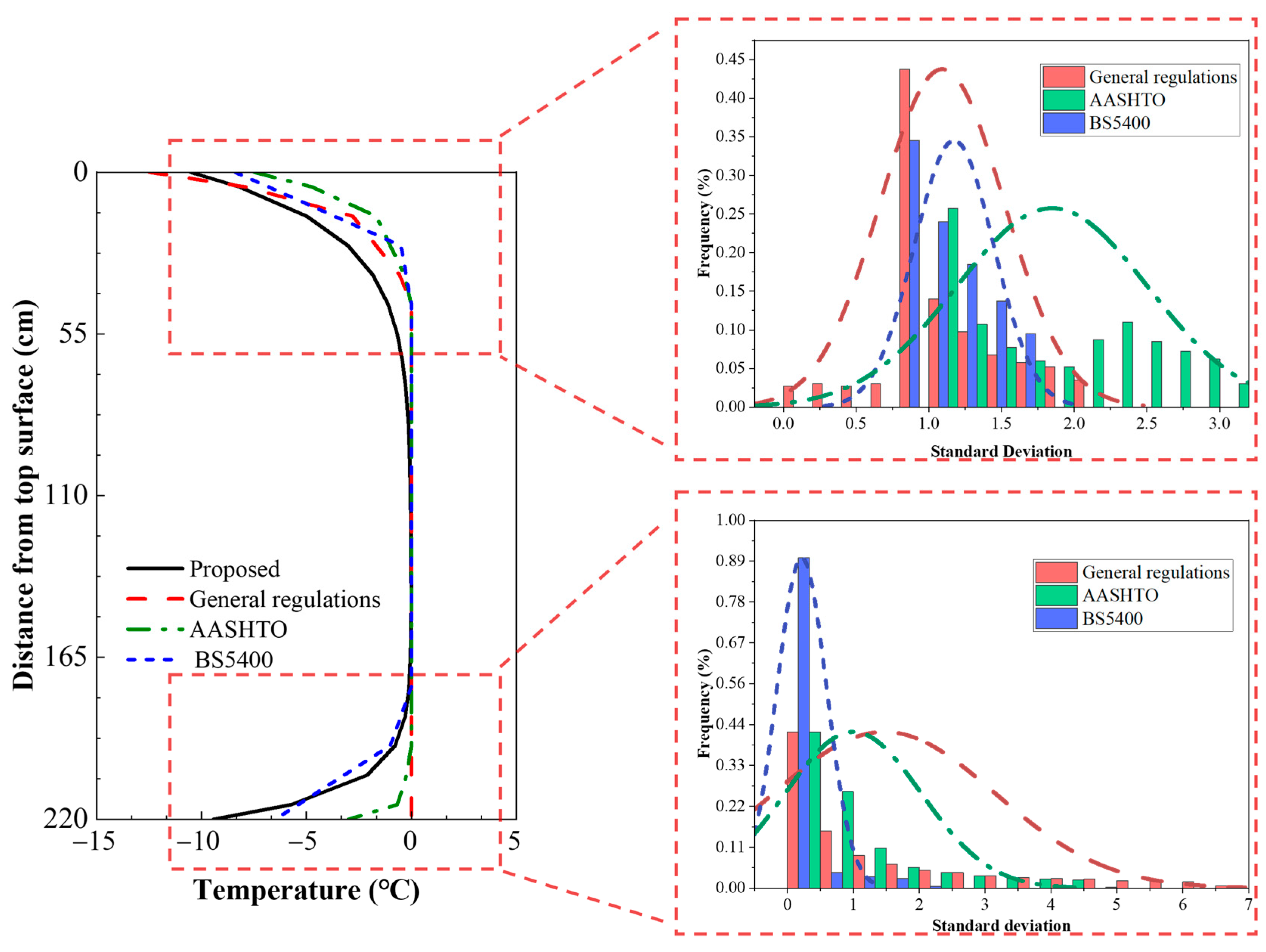

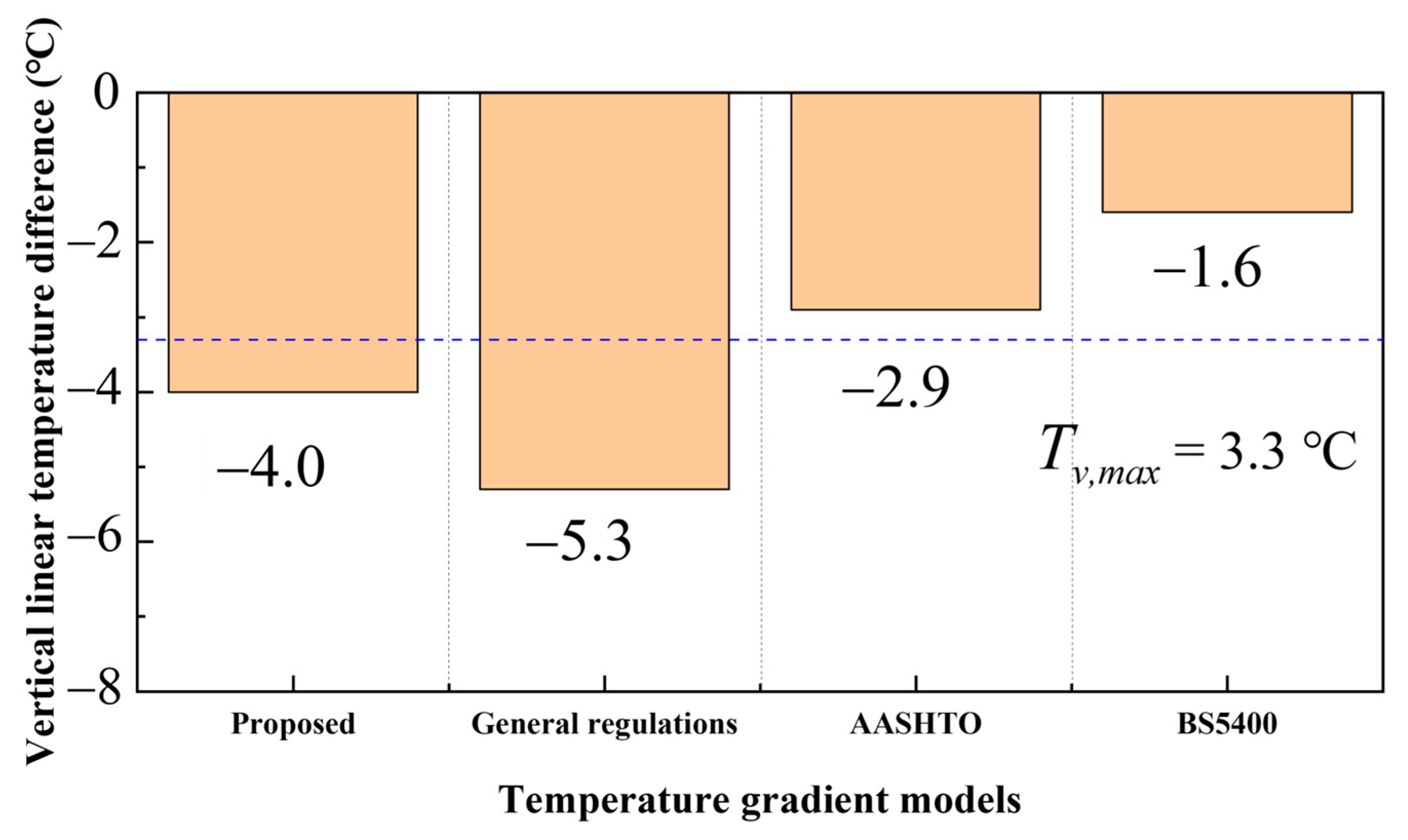
| Cooling Stage | Starting Time | End Time | Cooling Time/h | Tmax /°C | Tmin /°C | Cooling Range/°C | Return Period/Day |
|---|---|---|---|---|---|---|---|
| Cooling stage I | 12/1 17:46 | 13/1 5:41 | 11.92 | −5.24 | −21.75 | 16.51 | 30.15 |
| Cooling stage II | 14/1 12:43 | 15/1 2:01 | 13.30 | −10.42 | −28.81 | 18.39 | 49.76 |
| Cooling stage III | 15/1 16:47 | 16/1 8:36 | 15.82 | −15.61 | −30.23 | 14.62 | 20.60 |
| Cooling Stage | Starting Time | End Time | Cooling Time/h | Tmax/°C | Tmin/°C | Cooling Range/°C |
|---|---|---|---|---|---|---|
| Cooling stage I | 12/1 18:00 | 13/1 10:00 | 16.00 | −7.72 | −13.65 | 5.93 |
| Cooling stage II | 14/1 16:00 | 15/1 11:00 | 19.00 | −10.91 | −18.15 | 7.24 |
| Cooling stage III | 15/1 18:00 | 16/1 10:00 | 16.00 | −16.47 | −21.79 | 5.32 |
| Characteristic | Concrete |
|---|---|
| Density ρ, kg/m3 | 2300 |
| Specific heat capacity c, J/(kg·°C) | 900 |
| Thermal conductivity λ, W/(m·°C) | 3 |
| Solar radiation absorptivity α | 0.4 |
| Radiation coefficient ε | 0.85 |
| Temperature Differential | GP Distribution Model Parameters | Extreme Values of 23-Year Finite Element Calculation Data/°C | Representative Value of 50-Year Return Period/°C | |||
|---|---|---|---|---|---|---|
| Type | k | σ | u | |||
| T1 | Type III distribution | −0.093 | 1.097 | 4.72 | −10.08 | −10.54 |
| T2 | Type III distribution | −0.254 | 1.035 | 6.01 | −9.01 | −9.44 |
Disclaimer/Publisher’s Note: The statements, opinions and data contained in all publications are solely those of the individual author(s) and contributor(s) and not of MDPI and/or the editor(s). MDPI and/or the editor(s) disclaim responsibility for any injury to people or property resulting from any ideas, methods, instructions or products referred to in the content. |
© 2024 by the authors. Licensee MDPI, Basel, Switzerland. This article is an open access article distributed under the terms and conditions of the Creative Commons Attribution (CC BY) license (https://creativecommons.org/licenses/by/4.0/).
Share and Cite
Li, H.; Ba, Y.-K.; Zhang, N.; Liu, Y.-J.; Shi, W. Temperature Distribution Characteristics and Action Pattern of Concrete Box Girder under Low-Temperature and Cold Wave Conditions. Appl. Sci. 2024, 14, 3102. https://doi.org/10.3390/app14073102
Li H, Ba Y-K, Zhang N, Liu Y-J, Shi W. Temperature Distribution Characteristics and Action Pattern of Concrete Box Girder under Low-Temperature and Cold Wave Conditions. Applied Sciences. 2024; 14(7):3102. https://doi.org/10.3390/app14073102
Chicago/Turabian StyleLi, Hui, Yi-Kun Ba, Ning Zhang, Yong-Jian Liu, and Wei Shi. 2024. "Temperature Distribution Characteristics and Action Pattern of Concrete Box Girder under Low-Temperature and Cold Wave Conditions" Applied Sciences 14, no. 7: 3102. https://doi.org/10.3390/app14073102
APA StyleLi, H., Ba, Y.-K., Zhang, N., Liu, Y.-J., & Shi, W. (2024). Temperature Distribution Characteristics and Action Pattern of Concrete Box Girder under Low-Temperature and Cold Wave Conditions. Applied Sciences, 14(7), 3102. https://doi.org/10.3390/app14073102








